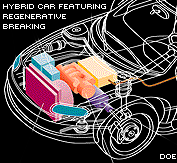Hybrid Cars: The Magic Braking
 You have undoubtedly seen one of the hybrid cars on the road. You probably heard that they are unlike any other fossil fuel or electric car. They are sort of both.
You have undoubtedly seen one of the hybrid cars on the road. You probably heard that they are unlike any other fossil fuel or electric car. They are sort of both.
If you owned one of these hybrid cars, you would put gasoline into it, just like you do for your regular car. You would not have to recharge it, like an electric car. Still, your hybrid car would be capable of using half the gasoline that your regular car does for the same trip! How is that possible? The secret is in the braking.
When you step on your brakes, what happens? The car slows down because two metal blocks in your wheels rub together. This friction-based braking produces a lot of heat; just like the palms of your hands get warm when you rub them together rapidly. This heat is basically wasted energy. Hybrid cars have a more intelligent braking system, so called regenerative braking. Instead of wasting the heat energy, they transfer it to an electrical generator and battery (and hence self-charge), or a fly-wheel and store it for later use. The onboard computer then calculates the best time to use this stored energy and reduce combustion engine use. Thus a hybrid car drives on combustion engine only part of the time. This switch between combustion engine and electric motor power is in most cases so seamless that you don't even notice it. This concept is ingenious and environment-friendly.
About the Author
Anton Skorucak, MS
 Anton Skorucak is a founder and publisher of ScienceIQ.com. Anton Skorucak has a Master of Science (MS) degree in physics from the University of Southern California, Los Angeles, California and a B.Sc. in physics with a minor in material science from the McMaster University, Canada. He is the president and creator of PhysLink.com, a comprehensive physics and astronomy online education, research and reference web site.
Anton Skorucak is a founder and publisher of ScienceIQ.com. Anton Skorucak has a Master of Science (MS) degree in physics from the University of Southern California, Los Angeles, California and a B.Sc. in physics with a minor in material science from the McMaster University, Canada. He is the president and creator of PhysLink.com, a comprehensive physics and astronomy online education, research and reference web site.


